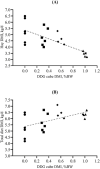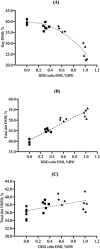Effects of supplementation rate of an extruded dried distillers' grains cube fed to growing heifers on voluntary intake and digestibility of bermudagrass hay
- PMID: 35325181
- PMCID: PMC9126203
- DOI: 10.1093/jas/skac097
Effects of supplementation rate of an extruded dried distillers' grains cube fed to growing heifers on voluntary intake and digestibility of bermudagrass hay
Abstract
Our objectives were to 1) investigate the difference in chemical composition and disappearance kinetics between loose dried distillers' grains (DDG) and extruded DDG cubes and 2) evaluate the effects of supplementation rate of extruded DDG cubes on voluntary dry matter intake (DMI), rate and extent of digestibility, and blood parameters of growing beef heifers offered ad libitum bermudagrass (Cynodon dactylon) hay. To characterize the changes in chemical composition during the extrusion process, loose and extruded DDG were evaluated via near-infrared reflectance spectroscopy, and dry matter (DM) disappearance kinetics were evaluated via time point in situ incubations. Extruded DDG cubes had greater (P ≤ 0.01) contents of fat, neutral detergent insoluble crude protein, and total digestible nutrients, but lower (P ≤ 0.01) neutral and acid detergent fiber than loose DDG. Additionally, the DM of extruded DDG cubes was more immediately soluble (P < 0.01), had greater (P < 0.01) effective degradability and lag time, and tended (P = 0.07) to have a greater disappearance rate than loose DDG. In the 29-d supplementation rate study, 23 Charolais-cross heifers were randomly assigned to one of four supplemental treatments: 1) control, no supplement; 2) low, 0.90 kg DDG cubes per d; 3) intermediate, 1.81 kg DDG cubes per d; or 4) high, 3.62 kg DDG cubes per d. Titanium dioxide was used as an external marker to estimate fecal output and particulate passage rate (Kp). Blood was collected from each animal to determine supplementation effects on blood metabolites. Indigestible neutral detergent fiber was used as an internal marker to assess the rate and extent of hay and diet DM digestibility (DMD). Increasing supplementation rate increased Kp and total diet DMI linearly (P < 0.01), yet linearly decreased (P < 0.01) hay DMI. Hay DMD decreased quadratically (P < 0.01), while total diet DMD increased linearly (P < 0.01) with increased DDG cube inclusion. Supplemented heifers had greater (P = 0.07) blood urea nitrogen concentrations than control animals 4 h post-supplementation. Intermediate and high rates of supplementation resulted in lower (P < 0.01) serum nonesterified fatty acid concentrations post-supplementation than control heifers. Concentrations of serum glucose and lactate were greatest (P ≤ 0.06) 8 h post-supplementation. Our results suggest that extruded DDG cubes may be an adequate supplement for cattle consuming moderate-quality forage, and further research is warranted.
Keywords: digestibility; disappearance; extruded dried distillers’ grains cube; intake; supplementation rate.
Plain language summary
Growing cattle are oftentimes provided supplemental concentrate as a source of protein and energy in order to meet performance goals when consuming low-quality forages. The effects of supplemental concentrate on forage intake vary, which may be related to the quality of forage and the characteristics of the supplement being evaluated. Dried distillers’ grains (DDG) are a by-product of ethanol production and have become a common supplement for growing cattle due to the increased energy and rumen undegradable protein content. A stable DDG cube made via a novel extrusion process may be advantageous for pasture supplementation due to the reduced risk of loss of product from wind and soil mixing that is common with loose DDG. The effects of supplementation rate of traditional concentrate sources on forage intake are abundant, but research regarding extruded DDG cubes is almost nonexistent. Thus, our objective was to evaluate extruded DDG cube supplementation rate (0, 0.90, 1.81, or 3.62 kg DDG cubes per d) for growing cattle on voluntary intake and digestibility of moderate-quality forage. Although increasing supplementation rate reduced forage intake and digestibility, total diet intake and digestibility were increased. Our results suggested that extruded DDG cubes have potential as a supplement for cattle consuming moderate-quality forage.
© The Author(s) 2022. Published by Oxford University Press on behalf of the American Society of Animal Science. All rights reserved. For permissions, please e-mail: journals.permissions@oup.com.
Figures






References
-
- Alvarado, C., Anrique R., and Navarrete S.. . 2009. Effect of including extruded, rolled or ground corn in dairy cow diets based on direct cut silage. Chil. J. Agric. Res. 69:356–365. doi:10.4067/S0718-58392009000300008 - DOI
-
- AOAC. 2000. Official methods of analysis, 17th ed. Gaithersburg (MD): The Association of Official Analytical Chemists.
-
- AOCS Official Procedure. 2005. Approved procedure Am 5-04, rapid determination of oil/fat utilizing high temperature solvent extraction. Urbana (IL): American Oil Chemists’ Society.
-
- Bowden, D. M. 1971. Non-esterified fatty acids and ketone bodies in blood as indicators of nutritional status in ruminants: a review. Can. J. Anim. Sci. 51:1–13. doi:10.4141/cjas71-001 - DOI
Publication types
MeSH terms
Substances
LinkOut - more resources
Full Text Sources

